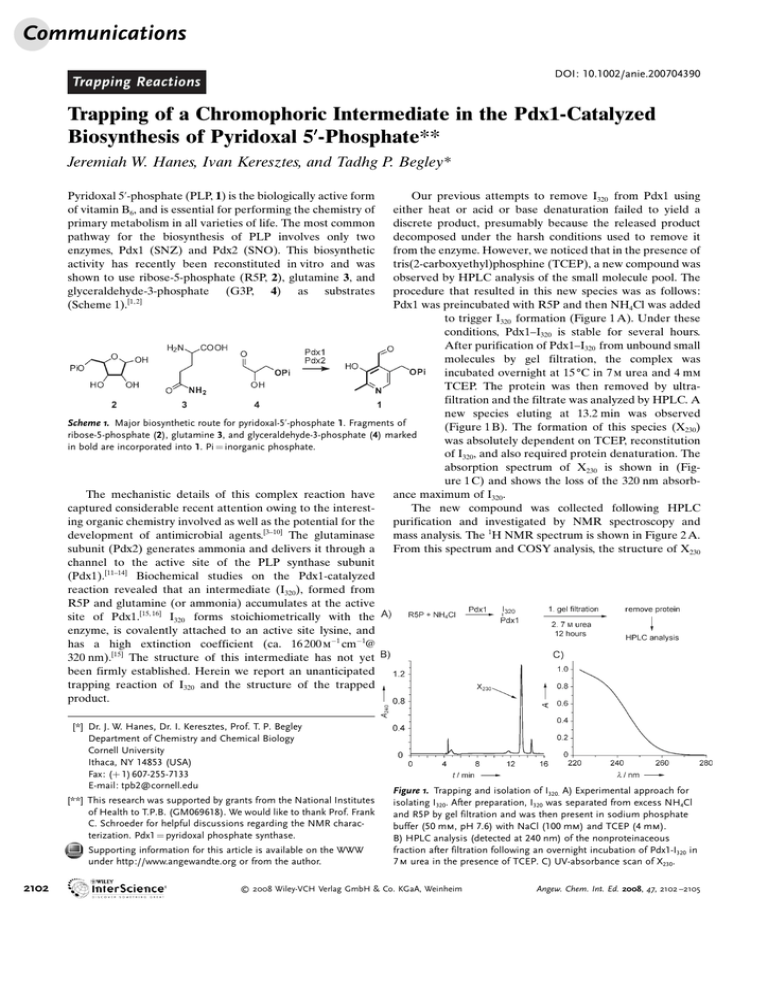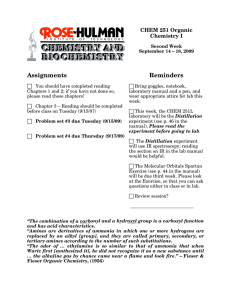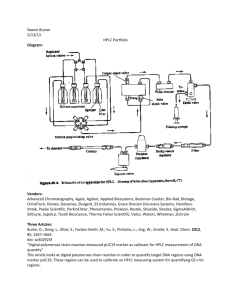Trapping of a Chromophoric Intermediate in the Pdx1-Catalyzed
advertisement

Communications DOI: 10.1002/anie.200704390 Trapping Reactions Trapping of a Chromophoric Intermediate in the Pdx1-Catalyzed Biosynthesis of Pyridoxal 5’-Phosphate** Jeremiah W. Hanes, Ivan Keresztes, and Tadhg P. Begley* Our previous attempts to remove I320 from Pdx1 using either heat or acid or base denaturation failed to yield a discrete product, presumably because the released product decomposed under the harsh conditions used to remove it from the enzyme. However, we noticed that in the presence of tris(2-carboxyethyl)phosphine (TCEP), a new compound was observed by HPLC analysis of the small molecule pool. The procedure that resulted in this new species was as follows: Pdx1 was preincubated with R5P and then NH4Cl was added to trigger I320 formation (Figure 1 A). Under these conditions, Pdx1–I320 is stable for several hours. After purification of Pdx1–I320 from unbound small molecules by gel filtration, the complex was incubated overnight at 15 8C in 7 m urea and 4 mm TCEP. The protein was then removed by ultrafiltration and the filtrate was analyzed by HPLC. A new species eluting at 13.2 min was observed Scheme 1. Major biosynthetic route for pyridoxal-5’-phosphate 1. Fragments of (Figure 1 B). The formation of this species (X230) ribose-5-phosphate (2), glutamine 3, and glyceraldehyde-3-phosphate (4) marked was absolutely dependent on TCEP, reconstitution in bold are incorporated into 1. Pi = inorganic phosphate. of I320, and also required protein denaturation. The absorption spectrum of X230 is shown in (Figure 1 C) and shows the loss of the 320 nm absorbance maximum of I320. The mechanistic details of this complex reaction have captured considerable recent attention owing to the interestThe new compound was collected following HPLC ing organic chemistry involved as well as the potential for the purification and investigated by NMR spectroscopy and development of antimicrobial agents.[3–10] The glutaminase mass analysis. The 1H NMR spectrum is shown in Figure 2 A. subunit (Pdx2) generates ammonia and delivers it through a From this spectrum and COSY analysis, the structure of X230 channel to the active site of the PLP synthase subunit (Pdx1).[11–14] Biochemical studies on the Pdx1-catalyzed reaction revealed that an intermediate (I320), formed from R5P and glutamine (or ammonia) accumulates at the active site of Pdx1.[15, 16] I320 forms stoichiometrically with the enzyme, is covalently attached to an active site lysine, and has a high extinction coefficient (ca. 16 200 m 1 cm 1@ 320 nm).[15] The structure of this intermediate has not yet been firmly established. Herein we report an unanticipated trapping reaction of I320 and the structure of the trapped product. Pyridoxal 5’-phosphate (PLP, 1) is the biologically active form of vitamin B6, and is essential for performing the chemistry of primary metabolism in all varieties of life. The most common pathway for the biosynthesis of PLP involves only two enzymes, Pdx1 (SNZ) and Pdx2 (SNO). This biosynthetic activity has recently been reconstituted in vitro and was shown to use ribose-5-phosphate (R5P, 2), glutamine 3, and glyceraldehyde-3-phosphate (G3P, 4) as substrates (Scheme 1).[1, 2] [*] Dr. J. W. Hanes, Dr. I. Keresztes, Prof. T. P. Begley Department of Chemistry and Chemical Biology Cornell University Ithaca, NY 14853 (USA) Fax: (+ 1) 607-255-7133 E-mail: tpb2@cornell.edu [**] This research was supported by grants from the National Institutes of Health to T.P.B. (GM069618). We would like to thank Prof. Frank C. Schroeder for helpful discussions regarding the NMR characterization. Pdx1 = pyridoxal phosphate synthase. Supporting information for this article is available on the WWW under http://www.angewandte.org or from the author. 2102 Figure 1. Trapping and isolation of I320. A) Experimental approach for isolating I320. After preparation, I320 was separated from excess NH4Cl and R5P by gel filtration and was then present in sodium phosphate buffer (50 mm, pH 7.6) with NaCl (100 mm) and TCEP (4 mm). B) HPLC analysis (detected at 240 nm) of the nonproteinaceous fraction after filtration following an overnight incubation of Pdx1-I320 in 7 m urea in the presence of TCEP. C) UV-absorbance scan of X230. 2008 Wiley-VCH Verlag GmbH & Co. KGaA, Weinheim Angew. Chem. Int. Ed. 2008, 47, 2102 –2105 Angewandte Chemie Figure 2. Structural characterization of X230 (5). A) 1H NMR spectrum (600 MHz) of purified X230 in D2O. The protons corresponding to b and c exchanged with solvent over time (b: several hours, c: several days). The solvent signal at d = 4.8 ppm was suppressed by presaturation. B) ESI-MS analysis of X230 performed in positive mode. The peak labeled at m/z = 251.2 corresponds to the + 1 ion of TCEP, which is likely a fragment of the species responsible for the peak seen at m/ z = 346.1. m/z = 346.1 is consistent with the + 1 ion of 5. was tentatively assigned as 5. ESI-MS analysis was also in good agreement with the proposed structure (Figure 2 B). Although this analysis was consistent with a nitrogencontaining heterocycle, it did not directly demonstrate the presence of the nitrogen atom. Establishing the presence of a nitrogen atom in I320 is of critical importance for our analysis of the mechanism of PLP formation. Previous data, obtained by high-resolution MS analysis of an I320-labeled peptide from a tryptic digest, suggested that the glutamine-derived nitrogen atom was not covalently incorporated into I320.[15] However, separate experiments demonstrated that gel-purified I320 can be converted into PLP by the addition of G3P in the absence of any ammonia source.[16] This suggests that the ammonia is covalently bound to I320. The isolation of X230 allowed us to perform a direct experiment to probe for the presence of the nitrogen atom in I320. To do this, Pdx1–I320 formation was triggered using 15Nenriched NH4Cl, and X230 was purified by HPLC. The 1H NMR spectrum obtained in 20 % D2O is shown in Figure 3 A, and is consistent with structure 5. This assignment is also supported by a variety of additional 2D NMR spectra (see Supporting Information). The large doublet of apparent triplets at d = 9.8 ppm suggested that Ha was coupled to 15N. To confirm this, the proton spectrum was measured with and without broadband 15N decoupling. From the pair of spectra (Figure 3 B), it is clear that the heterocycle contains an 15N atom that is coupled to each of the protons responsible for signals downfield of d = 3.5 ppm (a–d). As expected, the signals present in the aliphatic region of the sprectrum (d = 2.5–2.8 ppm) were not affected by 15N decoupling (e–f). This analysis demonstrates that ammonia is incorporated into I320 Angew. Chem. Int. Ed. 2008, 47, 2102 –2105 Figure 3. 15N decoupling analysis of X230. I320 was constituted using 15 NH4Cl, and then isolated according to Figure 1 A. A) 1H NMR spectrum (600 MHz) of purified I320 in 20 % D2O/80 % H2O (20 % D2O was used because the signals corresponding to a, c, and d exchanged with solvent over time). Processing of the data included solvent subtraction. B) Comparison of sections of the 1H NMR spectrum shown in (A) to a spectrum obtained with broadband 15N decoupling applied. Signals corresponding to a, b, c, and d were significantly simplified by 15 N decoupling. Processing of the data included the application of an unshifted sine–bell function prior to Fourier transformation to increase resolution. in a covalent manner, and that X230 is a novel adduct of TCEP and I320. From previous work, it was shown that 6 is a likely structure for I320.[16] This proposal is based on the following: 1) I320 reacts with G3P to give PLP in the absence of ammonia, suggesting that ammonia is covalently bound; 2) I320 must be a highly conjugated system to account for its long-wavelength absorption; 3) the observation of a primary deuterium kinetic isotope effect on the formation of I320 using C5 pro-R deuterium-labeled suggests that one of the CH2 protons of R5P is absent from I320 ; 4) phosphate elimination is stoichiometric with the production of I320, demonstrating that I320 does not contain phosphate; and 5) analysis of the formation of I320 from 9 by ESI-FTMS is consistent with structure 6. A mechanistic proposal for the formation of 6 is shown in Scheme 2. In the absence of other substrates, R5P is ring-opened to the aldehyde 7, and imine formation with the active-site lysine would give 8 which then rearranges to ketone 9. This species is poised for ammonia addition at C2 to give imine 10. This event triggers the next series of reactions leading to I320. Elimination of water gives 11, and then rearrangement to 12 occurs by deprotonation at C5. Elimination of the lysine from C1 generates 13, and then the same lysine residue adds to C5 resulting in 14, which facilitates phosphate elimination to give I320 6. During the normal catalytic cycle of Pdx1, the addition of G3P to I320 results in PLP formation in a series of reactions that are not yet well understood. The detection of 5 as a trapped product derived from I320 is consistent with our assignment of structure 6 to the chromophoric intermediate. We propose (Scheme 3) that upon 2008 Wiley-VCH Verlag GmbH & Co. KGaA, Weinheim www.angewandte.org 2103 Communications N2 for storage. At this point the protein concentration was approximately 2.15 mm. To prepare X230, Pdx1 (2.15 mm, 1.5 mL) was mixed with a final concentration of d-ribose-5-phosphate (1.5 mm, Sigma–Aldrich) and incubated at room temperature for 20 min. Only 1.5 mm ribose-5-phosphate was used because approximately 60 % of the active sites contain the pentose-5P as a result of copurification. NH4Cl was added as a solid to a final concentration of 1m, and the reaction mixture was incubated for 1 hour. At this time the Pdx1-I320 was purified from the excess salt and small molecules using a 10DG gel filtration column (Bio-Rad) according to the product instructions. The column was preequilibrated with sodium phosphate Scheme 2. Mechanistic proposal for the formation of I320. For compounds 2–14, carbon atoms are buffer (50 mm, pH 7.6) containing defined as (right to left) C1–C5. See text for details. 300 mm NaCl and 4 mm TCEP. Solid urea was then added to the protein to a final concentration of 7 m and the mixture was vortexed until the urea was dissolved. The sample was then incubated for 12 h at 15 8C to allow the reaction to take place. Many products were observed if this incubation temperature was raised to 37 8C. The protein was removed from X230 by ultrafiltration using a 10 000 kDa-cutoff Amicon Ultra-4 centrifugal filter unit at 4 8C (Millipore). X230 was purified by HPLC using a Supelcosil LC-18-T column (25 cm G 10 mm, 5 mm) equilibrated with water containing 0.1 % trifluoroacetic acid (TFA), and eluted with a gradient of MeOH containing 0.1 % TFA. The HPLC method is reported in the Supporting Information. The major species was collected over the course of several injections, pooled, and then the solvent removed with a rotary Scheme 3. Proposed route for the formation of 5. See text for details. evaporator prior to lyophilization. Following lyophilization the solid was directly dissolved in water or D2O for MS or NMR spectroscopic analysis. denaturation, TCEP (15) adds to 6 to give 16, which then tautomerizes to 17 and cyclizes to 18 releasing it from the lysine residue. Aromatization gives pyrrole 5. The unanticipated trapping of I320 by TCEP demonstrates that ammonia is covalently bound to I320, and supports our assignment of structure 6 to this intermediate.[15] However, a previous MS analysis of a peptide fragment (trypsin digest) containing I320 suggested that it was not a nitrogen-containing compound. One explanation for this discrepancy is that 6 isomerizes upon exposure to solvent and the resulting imine undergoes hydrolysis, leading to the loss of ammonia. The current study also suggests that TCEP (and other phosphines), which is generally viewed as an inert buffer component used to protect thiols from oxidation, may have applications in the trapping of other enzyme-bound a,bunsaturated aldehydes, ketones and imines. Experimental Section Procedure for the isolation of X230 : The overexpression and purification of B. subtilis Pdx1 has been described in detail.[1, 16] Following elution from the Ni2+-based affinity chromatography column, the protein was dialyzed extensively against sodium phosphate buffer (50 mm, pH 7.6) containing NaCl (300 mm), TCEP (2 mm), and 25 % glycerol. The protein was then aliquoted and flash-frozen with liquid 2104 www.angewandte.org Received: September 23, 2007 Published online: February 7, 2008 . Keywords: biosynthesis · intermediates · phosphines · pyridoxal · vitamin B6 [1] K. E. Burns, Y. Xiang, C. L. Kinsland, F. W. McLafferty, T. P. Begley, J. Am. Chem. Soc. 2005, 127, 3682 – 3683. [2] T. Raschle, N. Amrhein, T. B. Fitzpatrick, J. Biol. Chem. 2005, 280, 32291 – 32300. [3] M. Tambasco-Studart, I. Tews, N. Amrhein, T. B. Fitzpatrick, Plant Physiol. 2007, 144, 915 – 925. [4] M. Neuwirth, K. Flicker, M. Strohmeier, I. Tews, P. Macheroux, Biochemistry 2007, 46, 5131 – 5139. [5] S. A. Denslow, E. E. Rueschhoff, M. E. Daub, Plant Physiol. Biochem. 2007, 45, 152 – 161. [6] M. Tambasco-Studart, O. Titiz, T. Raschle, G. Forster, N. Amrhein, T. B. Fitzpatrick, Proc. Natl. Acad. Sci. USA 2005, 102, 13687 – 13692. [7] C. Wrenger, M. L. Eschbach, I. B. MIller, D. Warnecke, R. D. Walter, J. Biol. Chem. 2004, 280, 5242 – 5248. [8] D. K. Wetzel, M. Ehrenshaft, S. A. Denslow, M. E. Daub, FEBS Lett. 2004, 564, 143 – 146. [9] Y. X. Dong, S. Sueda, J. Nikawa, H. Kondo, Eur. J. Biochem. 2004, 271, 745 – 752. 2008 Wiley-VCH Verlag GmbH & Co. KGaA, Weinheim Angew. Chem. Int. Ed. 2008, 47, 2102 –2105 Angewandte Chemie [10] M. Ehrenshaft, M. E. Daub, J. Bacteriol. 2001, 183, 3383 – 3390. [11] J. A. Bauer, E. M. Bennett, T. P. Begley, S. E. Ealick, J. Biol. Chem. 2003, 279, 2704 – 2711. [12] M. Gengenbacher, T. B. Fitzpatrick, T. Raschle, K. Flicker, I. Sinning, S. MIller, P. Macheroux, I. Tews, B. Kappes, J. Biol. Chem. 2005, 281, 3633 – 3641. [13] F. Zein, Y. Zhang, Y. N. Kang, K. Burns, T. P. Begley, S. E. Ealick, Biochemistry 2006, 45, 14609 – 14620. Angew. Chem. Int. Ed. 2008, 47, 2102 –2105 [14] M. Strohmeier, T. Raschle, J. Mazurkiewicz, K. Rippe, I. Sinning, T. B. Fitzpatrick, I. Tews, Proc. Natl. Acad. Sci. USA 2006, 103, 19284 – 19289. [15] T. Raschle, D. Arigoni, R. Brunisholz, H. Rechsteiner, N. Amrhein, T. B. Fitzpatrick, J. Biol. Chem. 2006, 282, 6098 – 6105. [16] J. W. Hanes, K. E. Burns, D. G. Hilmey, A. Chatterjee, P. C. Dorrestein, T. P. Begley, J. Am. Chem. Soc. 2008, DOI: 10.1021/ ja076604l. 2008 Wiley-VCH Verlag GmbH & Co. KGaA, Weinheim www.angewandte.org 2105



